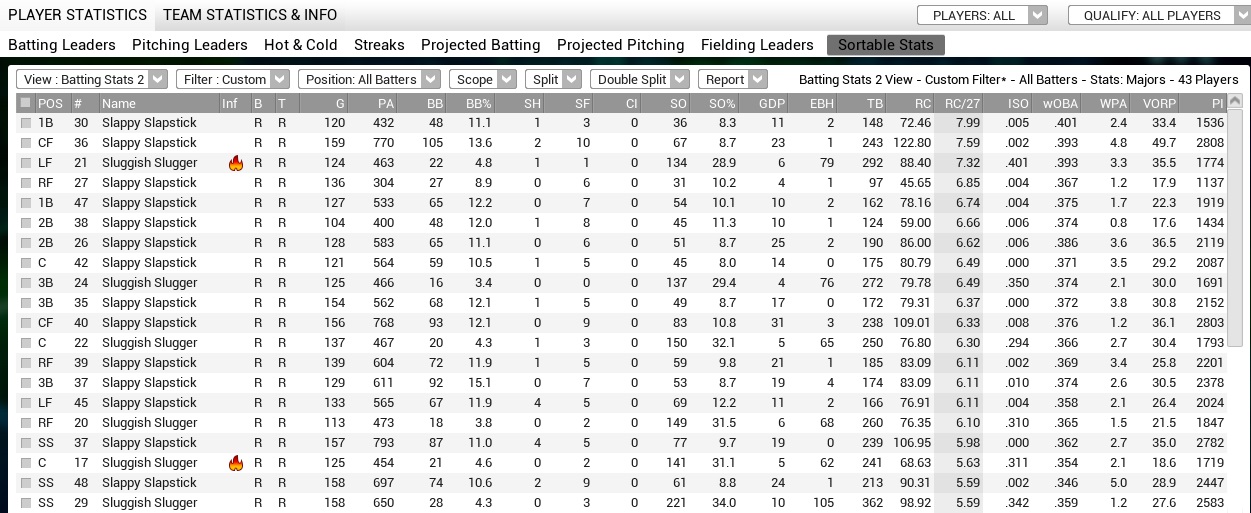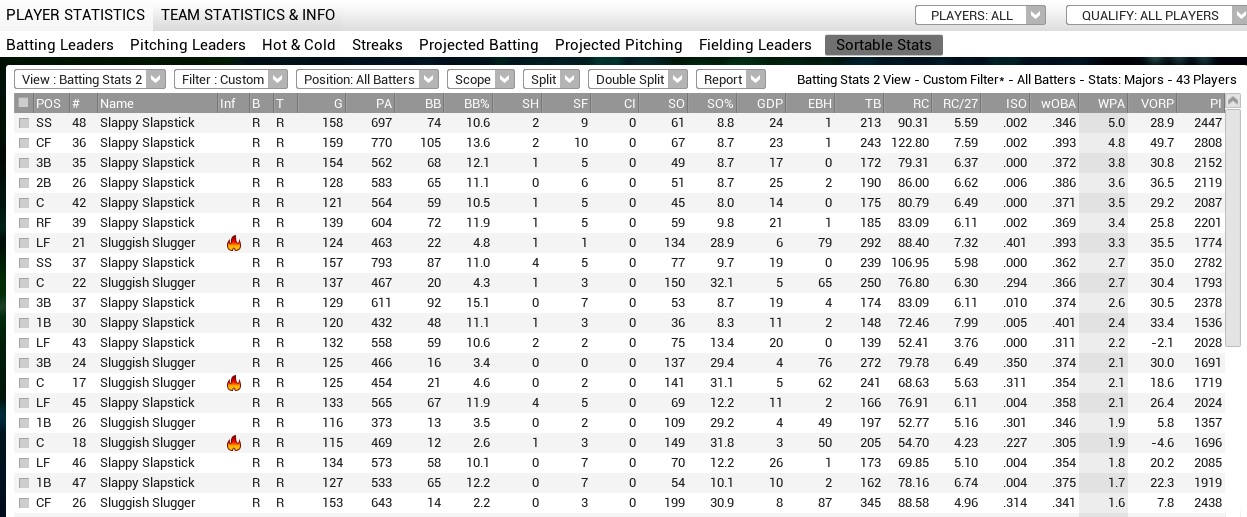I’ve been hooked on Out of the Park Baseball since OOTP 3 (since OOTP16 will be coming out this year it’ll be about 13 years) and have found that its breadth and realism only improves with each version. I won’t go through all of its capabilities here, but it’s absolutely worth the purchase if you’re into baseball simulations.
One of my projects with OOTP was to rerun all of MLB history using OOTP. Baseball more than any other sport clings to its history so it was interesting to see what an equally plausible history might have been like.
I just started it in 1871 and let it sim by itself all the way to the end of 2014 only checking periodically to adjust who made the Hall of Fame. The only change I made was that players were drafted instead of playing for the teams they really played for.
This alternative history looks quite different.
One example is Cy Young. It turns out in our alternate universe Cy wrecked his shoulder in 1900 and ended up with a respectable but unmemorable 193 career wins. The Cy Young award became the Charlie J Ferguson award. Ferguson, who in real life only pitched 4 pretty good seasons before succumbing to typhoid fever prior to the 1888 season (99-64 career record going 30-9 in 1886) pitched in this alternate universe from 1884 to 1906 compiling a 475-375 record and a whopping 218 career WAR.
Babe Ruth was a good enough pitcher and bad enough fielder that he stayed with pitching, finishing with 233 career wins. He failed to make the Hall of Fame.
Hank Aaron (326 HR), Willie Mays (336 HR), Willie McCovey (253 HR) all fell short as they succumbed to injuries prematurely. Same with Bob Gibson (85 career W). None are a real part of that universe’s baseball lore.
However, Tony Conigliaro never got beaned in the face, and for a time was the HR king (passing Mickey Mantle), and after 2014 was still second all-time with 681 HR. Mark McGwire’s body didn’t break down and he’s the home run leader at 687. Sosa and Bonds had subpar careers due to injury. Mantle and Ted Williams each won the MVP award 10 times while Denny McClain never got into trouble with the mob and finished with 7 Charlie Ferguson awards, the most ever.
Sandy Koufax did a John Smoltz and for a while was the career saves leader with 351, but was surpassed by Masanori Murakami. In the real world, Murakami was the first Japanese player in the majors but played only 2 seasons for the Giants before he contractually had to return to Japan. Here he stayed in the majors and finished with 502 career saves. He was later surpassed by Rob Dibble (528) and Robb Nen (629).
The best single season in this alternative universe belonged to Lou Gehrig (1930) – .451BA, 45HR, 126RBI, 14.1WAR and that’s with missing 7 weeks due to *gasp* injury. Those seven weeks actually limited him to only 490 plate appearances, below the threshold to qualify for top season batting average.
Johnny Damon was lucky enough to play for Colorado and was the last player to hit .400, going .406 in 1999 with 37HR and 150RBI to boot (10.1 WAR).
The best hitter of all-time would be an argument between Rogers Hornsby and Ted Williams, depending upon whether you favored WAR or OPS as your defining statistic. Given changes in the game across the years, WAR would likely be the best metric to determine an all-time best hitter. Hornsby played from 1915 to 1940. He’s the all-time hit leader with 4378. He smacked 446 HR, had 2229 RBI and is 1st all-time in career VORP (1510) and WAR (150). Williams played from 1939 to 1958 hitting 569 HR with 1740 RBI, a .337 BA. He was first all-time in career OPS (1.071).
The all-time leaders in WAR are:
– Rogers Hornsby (150)
– Luis Gonzalez (142?!?!?)
– Ted Williams (134)
– Mickey Mantle (134)
– Albert Pujols (132 – still active)
The longest hitting streak was 46 games by the legendary Possum Whitted who in our alternate universe played from 1912-1924 with a career .284 average and 7.2 WAR. In real life he played mostly as a part-timer from 1912-1922, with a career .269 BA. Mo Vaughn had the 3rd longest hitting streak at 44 games.
Your all-time great franchise is the Athletics (PHI-KC-OAK) with 38 playoff appearances and 13 World Series titles (both tops). The Yanks haven’t won the World Series since 1941 while the 1950’s belonged to Detroit who appeared in 5 of 6 WS from 1950-55 and won 4 of them, then winning again in ’58. The AL won 14 of 15 WS from 1958-1972. The Brewers franchise (starting with the Seattle Pilots in ’69) is your model of futility appearing in the playoffs only once and having a .421 lifetime winning percentage.
While all this is interesting to think about it also brings up a question about OOTP and the accuracy of its simulations. All the major milestone records I’ve noted thus far are all below real-life records. Is this a limitation of all types of sims? Career records for HR, BA, RBI, W, S, are all higher in real-life than in this alternate universe, but both Hornsby and Ty Cobb had more hits than Pete Rose (4378 and 4377 respectively – Rose only finished with 2514). The record for career triples was blown away (Sam Crawford beat himself out on that one 384 to 309). Jim Handiboe demolished the real-world record for career losses. Jim had a 443-484 record in our alternate universe playing for bad Brooklyn teams from 1886-1911 compared to Cy Young’s 316 real-world losses. There were a few single season outliers such as Gehrig’s .451 season and Richie Sexson knocking in 190 runs in 2000 in this alternate universe, but it’s too small a sample size with too many other factors to jump to any conclusions.
We are undertaking additional projects using OOTP which we will post, as we try to answer various what-if scenarios and age-old baseball questions using sims. We’re happy to take suggestions that we could address using OOTP. Feel free to leave those in the comments section.




